Impact and Recovery of Coastal Tourism Amid COVID-19: Tourism Flow Networks in Indonesia
Abstract
:1. Introduction
2. Materials and Methods
2.1. Study Area
2.2. Data Source and Processing
2.3. Method
2.3.1. DBSCAN Algorithm
2.3.2. Markov Chains
3. Results
3.1. The Spatial Distribution of Tourism Flows
3.2. Construction of Tourism Flow Networks
3.2.1. Tourist Focus Node Identification
3.2.2. Classification of Tourist Focus Nodes
3.3. Tourism Flow Network Structure
3.4. Tourism Resilience Driving Mechanism Analysis
4. Discussion and Conclusions
4.1. Findings
4.2. Suggestions
4.3. Limitations, and Further Research
Author Contributions
Funding
Institutional Review Board Statement
Informed Consent Statement
Data Availability Statement
Acknowledgments
Conflicts of Interest
References
- Liu, A.; Vici, L.; Ramos, V.; Giannoni, S.; Blake, A. Visitor arrivals forecasts amid COVID-19: A perspective from the Europe team. Ann. Tour. Res. 2021, 88, 103182. [Google Scholar] [CrossRef]
- Provenzano, D.; Volo, S. Tourism recovery amid COVID-19: The case of Lombardy, Italy. Tour. Econ. 2022, 28, 110–130. [Google Scholar] [CrossRef]
- Chotpitayasunondh, T.; Fisher, D.A.; Hsueh, P.-R.; Lee, P.-I.; Nogales Crespo, K.; Ruxrungtham, K. Exploring the role of serology testing to strengthen vaccination initiatives and policies for COVID-19 in Asia Pacific countries and territories: A discussion paper. Int. J. Transl. Med. 2022, 2, 275–308. [Google Scholar] [CrossRef]
- Luna, K.C.; Whetstone, C.C. Women, peace, and security and increasing gendered risk in the era of COVID-19: Insights from Nepal and Sri Lanka. Glob. Stud. Q. 2022, 2, ksac036. [Google Scholar] [CrossRef]
- Alsharif, A.H.; Salleh, N.Z.M.; Baharun, R. Neuromarketing: Marketing research in the new millennium. Neurosci. Res. Notes 2021, 4, 27–35. [Google Scholar] [CrossRef]
- Alsharif, A.H.; Md Salleh, N.Z.; Khraiwish, A. Biomedical technology in studying consumers’ subconscious behavior. Int. J. Online Biomed. Eng. 2022, 18, 98–114. [Google Scholar] [CrossRef]
- González-Reverté, F.; Gomis-López, J.M.; Díaz-Luque, P. Reset or temporary break? Attitudinal change, risk perception and future travel intention in tourists experiencing the COVID-19 pandemic. J. Tour. Futures 2022. online ahead of print. [Google Scholar] [CrossRef]
- Rahmiati, F.; Othman, N.A.; Bakri, M.H.; Ismail, Y.; Amin, G. Tourism service quality and tourism product availability on the loyalty of the Journal of Asian Finance. Econ. Bus. 2020, 7, 959–968. [Google Scholar] [CrossRef]
- Lesmana, H.; Sugiarto, S. Formulating a competitive advantage model for tourism destinations in Indonesia. J. Asian Fin. Econ. Bus. 2021, 8, 237–249. [Google Scholar] [CrossRef]
- Sucheran, R. Preliminary economic impacts of the COVID-19 pandemic on the hotel sector in South Africa. Afr. J. Hosp. Tour. Leis. 2021, 10, 115–130. [Google Scholar] [CrossRef]
- García-Hernández, M.; De la Calle-Vaquero, M.; Yubero, C. Cultural heritage and urban tourism: Historic city centres under pressure. Sustainability 2017, 9, 1346. [Google Scholar] [CrossRef] [Green Version]
- Marrocu, E.; Paci, R. Different tourists to different destinations. Evidence from spatial interaction models. Tour. Manag. 2013, 39, 71–83. [Google Scholar] [CrossRef] [Green Version]
- Becken, S. Developing a framework for assessing resilience of tourism sub-systems to climatic factors. Ann. Tour. Res. 2013, 43, 506–528. [Google Scholar] [CrossRef]
- Gallego, I.; Font, X. Changes in air passenger demand as a result of the COVID-19 Crisis: Using big data to inform tourism policy. J. Sustain. Tour. 2021, 29, 1470–1489. [Google Scholar] [CrossRef]
- Chen, R.; Liang, C.-Y.; Hong, W.-C.; Gu, D.-X. Forecasting holiday daily tourist flow based on seasonal support vector regression with adaptive genetic algorithm. Appl. Soft Comput. 2015, 26, 435–443. [Google Scholar] [CrossRef]
- Miah, S.J.; Vu, H.Q.; Gammack, J.; McGrath, M. A big data analytics method for tourist behaviour analysis. Inf. Manag. 2017, 54, 771–785. [Google Scholar] [CrossRef] [Green Version]
- Egger, I.; Lei, S.I.; Wassler, P. Digital free tourism—An exploratory study of tourist motivations. Tour. Manag. 2020, 79, 104098. [Google Scholar] [CrossRef]
- Shih, H.-Y. Network characteristics of drive tourism destinations: An application of network analysis in tourism. Tour. Manag. 2006, 27, 1029–1039. [Google Scholar] [CrossRef]
- Mou, N.; Zheng, Y.; Makkonen, T.; Yang, T.; Tang, J.J.; Song, Y. Tourists’ digital footprint: The spatial patterns of tourist flows in Qingdao, China. Tour. Manag. 2020, 81, 104151. [Google Scholar] [CrossRef]
- Jiang, W.; Xiong, Z.; Su, Q.; Long, Y.; Song, X.; Sun, P. Using geotagged social media data to explore sentiment changes in tourist flow: A spatiotemporal analytical framework. ISPRS Int. J. Geo-Inf. 2021, 10, 135. [Google Scholar] [CrossRef]
- Qin, J.; Song, C.; Tang, M.; Zhang, Y.; Wang, J. Exploring the spatial characteristics of inbound tourist flows in China using geotagged photos. Sustainability 2019, 11, 5822. [Google Scholar] [CrossRef] [Green Version]
- Houston, J.B.; Hawthorne, J.; Perreault, M.F.; Park, E.H.; Goldstein Hode, M.; Halliwell, M.R.; Turner McGowen, S.E.; Davis, R.; Vaid, S.; McElderry, J.A.; et al. Social media and disasters: A functional framework for social media use in disaster planning, response, and research. Disasters 2015, 39, 1–22. [Google Scholar] [CrossRef]
- Naeem, M. Do Social media platforms develop consumer panic buying during the fear of COVID-19 pandemic. J. Retail. Consum. Serv. 2021, 58, 102226. [Google Scholar] [CrossRef]
- Majid, A.; Chen, L.; Chen, G.; Mirza, H.T.; Hussain, I.; Woodward, J. A context-aware personalized travel recommendation system based on geotagged social media data mining. Int. J. Geogr. Inf. Sci. 2013, 27, 662–684. [Google Scholar] [CrossRef]
- Yuan, Y.; Medel, M. Characterizing international travel behavior from geotagged photos: A case study of Flickr. PLoS ONE 2016, 11, e0154885. [Google Scholar] [CrossRef]
- Van Dijck, J. Flickr and the culture of connectivity: Sharing views, experiences, memories. Mem. Stud. 2011, 4, 401–415. [Google Scholar] [CrossRef] [Green Version]
- Barchiesi, D.; Moat, H.S.; Alis, C.; Bishop, S.; Preis, T. Quantifying international travel flows using Flickr. PLoS ONE 2015, 10, e0128470. [Google Scholar] [CrossRef]
- Li, L.; Goodchild, M.F.; Xu, B. Spatial, temporal, and socioeconomic patterns in the use of Twitter and Flickr. Cartogr. Geogr. Inf. Sci. 2013, 40, 61–77. [Google Scholar] [CrossRef]
- Lee, J.Y.; Tsou, M.-H. Mapping spatiotemporal tourist behaviors and hotspots through location-based photo-sharing service (Flickr) data. In Lecture Notes in Geoinformation and Cartography, Proceedings of the LBS 2018: 14th International Conference on Location Based Services, Zurich, Switzerland, 15–17 January 2018; Springer: Berlin/Heidelberg, Germany, 2018; pp. 315–334. [Google Scholar] [CrossRef]
- Yang, Y.; Zhang, C.X.; Rickly, J.M. A review of early COVID-19 research in tourism: Launching the Annals of Tourism Research’s Curated Collection on Coronavirus and Tourism. Ann. Tour. Res. 2021, 91, 103313. [Google Scholar] [CrossRef]
- Lean, H.H.; Smyth, R. Asian financial crisis, avian flu and terrorist threats: Are shocks to Malaysian tourist arrivals permanent or transitory? Asia Pac. J. Tour. Res. 2009, 14, 301–321. [Google Scholar] [CrossRef]
- Liu, B.; Huang, S.S.; Fu, H. An application of network analysis on tourist attractions: The case of Xinjiang, China. Tour. Manag. 2017, 58, 132–141. [Google Scholar] [CrossRef]
- Alderighi, M.; Gaggero, A.A. Flight availability and international tourism flows. Ann. Tour. Res. 2019, 79, 102642. [Google Scholar] [CrossRef]
- Zheng, Y.; Mou, N.; Zhang, L.; Makkonen, T.; Yang, T. Chinese tourists in Nordic countries: An analysis of spatio-temporal behavior using geo-located travel blog data. Comput. Environ. Urban Syst. 2021, 85, 101561. [Google Scholar] [CrossRef]
- Brandão, F.; Breda, Z.; Costa, C. Innovation and internationalization as development strategies for coastal tourism destinations: The role of organizational networks. J. Hosp. Tour. Manag. 2019, 41, 219–230. [Google Scholar] [CrossRef]
- Aswicahyono, H.; Friawan, D. Infrastructure development in Indonesia. In International Infrastructure Development in East Asia-Towards International Infrastructure Development in East Asia-Towards Balanced Regional Development and Integration, ERIA Research Project Report; ERIA: Jakarta, Indonesia, 2007; Volume 2. [Google Scholar]
- Satyarini, N.W.M.; Rahmanita, M.; Setarnawat, S. The influence of destination image on tourist intention and decision to visit tourist destination (A case study of Pemuteran Village in Buleleng, Bali, Indonesia). Tour. Res. J. 2017, 1, 81–97. [Google Scholar] [CrossRef] [Green Version]
- Muhyiddin, M.; Nugroho, H. A year of COVID-19: A long road to recovery and acceleration of Indonesia’s development. JPP 2021, 5, 1–19. [Google Scholar] [CrossRef]
- Sreeramula, S.; Rahardjo, D. Estimating COVID-19 Rt in real-time: An Indonesian health policy perspective. Mach. Learn. Appl. 2021, 6, 100136. [Google Scholar] [CrossRef] [PubMed]
- World Health Organization. Available online: https://www.who.int (accessed on 1 March 2022).
- Thomee, B.; Shamma, D.A.; Friedland, G.; Elizalde, B.; Ni, K.; Poland, D.; Borth, D.; Li, L.-J. YFCC100M: The new data in multimedia research. Commun. ACM 2016, 59, 64–73. [Google Scholar] [CrossRef] [Green Version]
- Andrade, G.; Ramos, G.; Madeira, D.; Sachetto, R.; Ferreira, R.; Rocha, L. G-Dbscan: A GPU accelerated algorithm for density-based clustering. Procedia Comput. Sci. 2013, 18, 369–378. [Google Scholar] [CrossRef]
- Birant, D.; Kut, A. ST-DBSCAN: An algorithm for clustering spatial-temporal data. Data Knowl. Eng. 2007, 60, 208–221. [Google Scholar] [CrossRef]
- Hahsler, M.; Piekenbrock, M.; Doran, D. Dbscan: Fast density-based clustering with R. J. Stat. Softw. 2019, 91, 1–30. [Google Scholar] [CrossRef] [Green Version]
- Meyn, S.P.; Tweedie, R.L. Stability of Markovian Processes I: Criteria for discrete-time chains. Adv. Appl. Probab. 1992, 24, 542–574. [Google Scholar] [CrossRef] [Green Version]
- Privault, N. Understanding Markov Chains. In Examples and Applications; Springer: Singapore, 2013; Volume 357, p. 358. [Google Scholar]
- Meng, W.; Ma, R.; Chen, H.-H. Smart grid neighborhood area networks: A Survey. IEEE Netw. 2014, 28, 24–32. [Google Scholar] [CrossRef]
- Grinberger, A.Y.; Shoval, N.; McKercher, B. Typologies of tourists’ time-space consumption: A new approach using GPS Data. Tour. Geogr. 2014, 16, 105–123. [Google Scholar] [CrossRef]
- Keane, M.J. Quality and pricing in tourism destinations. Ann. Tour. Res. 1997, 24, 117–130. [Google Scholar] [CrossRef]
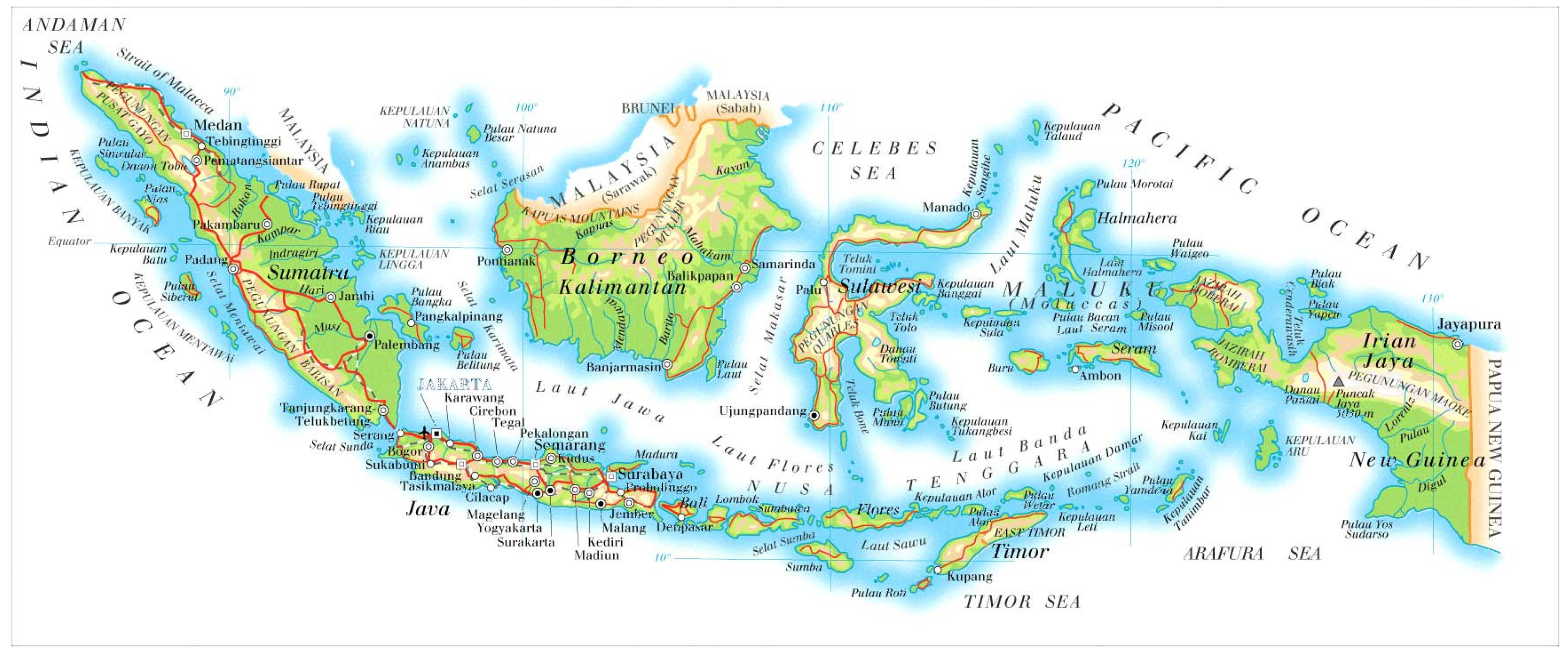
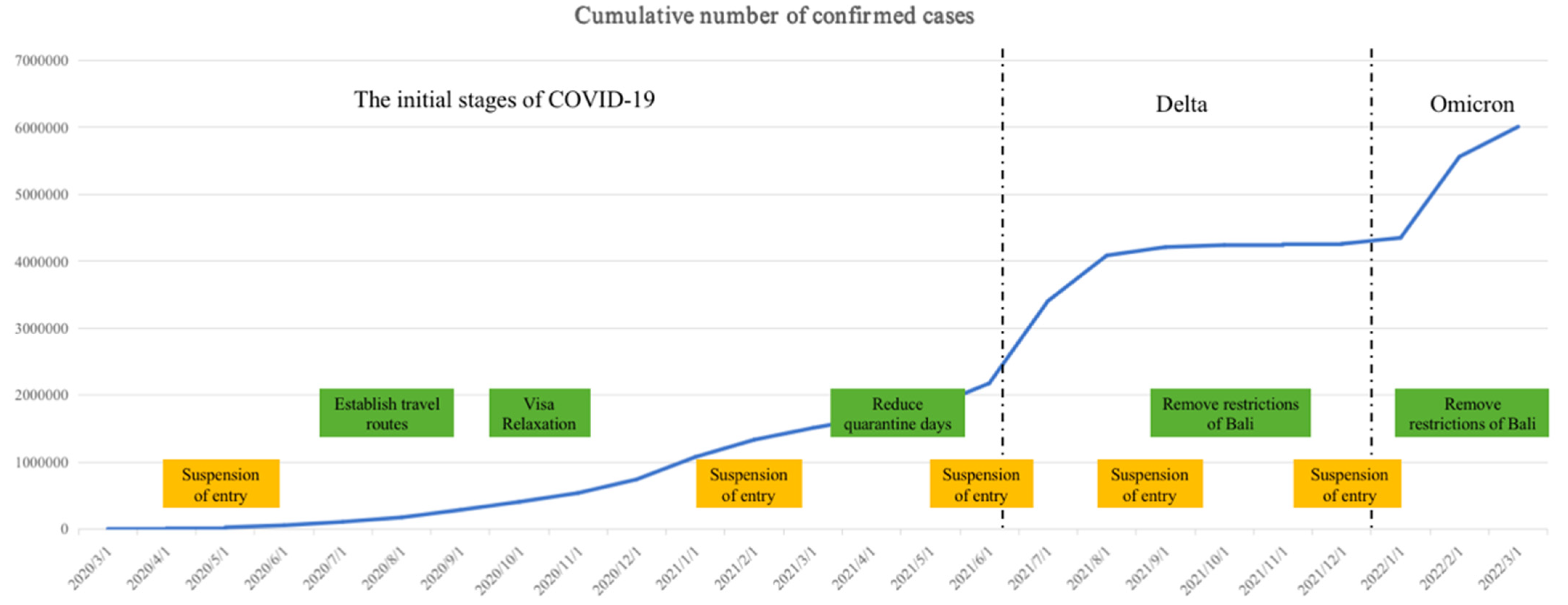

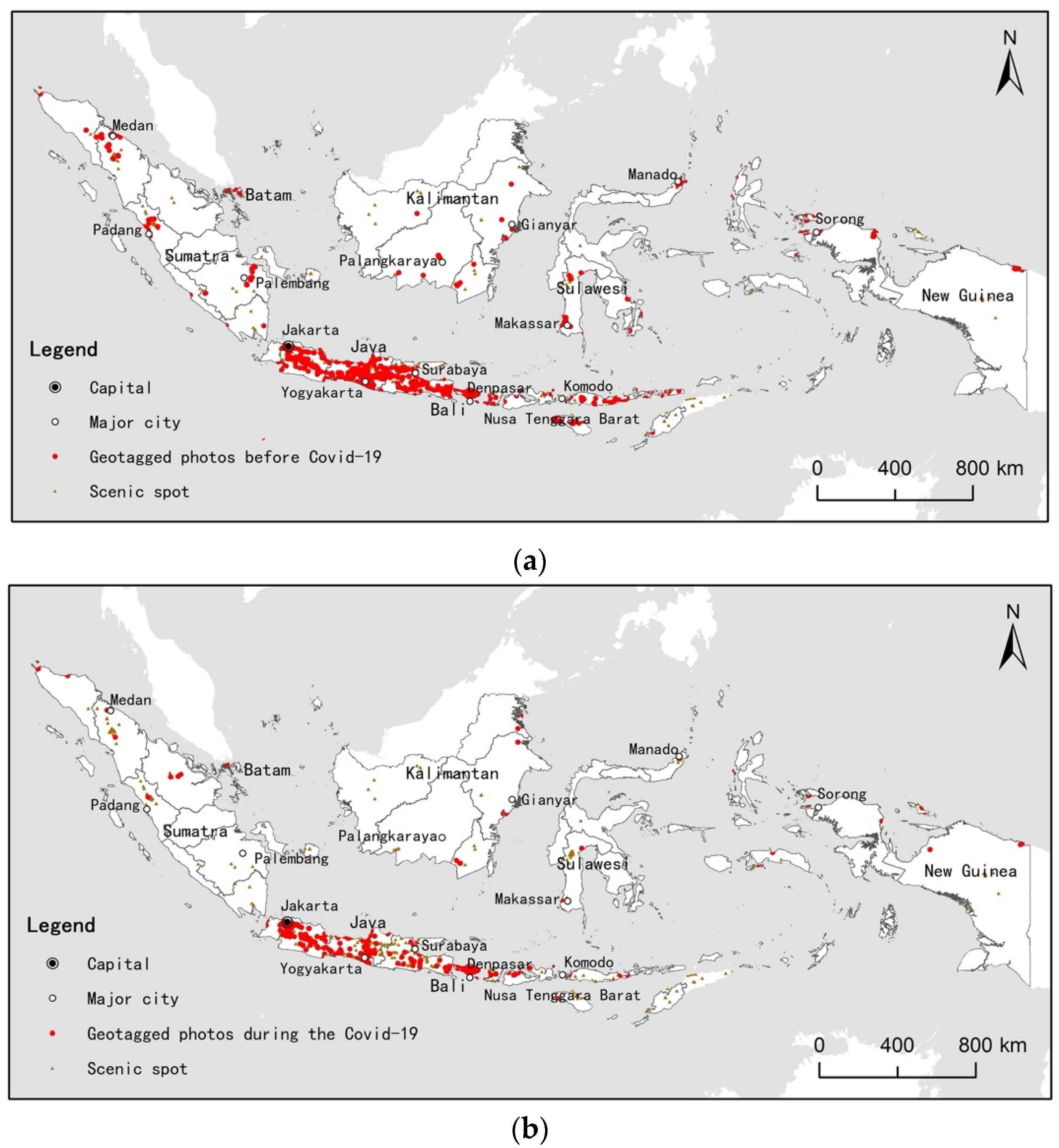
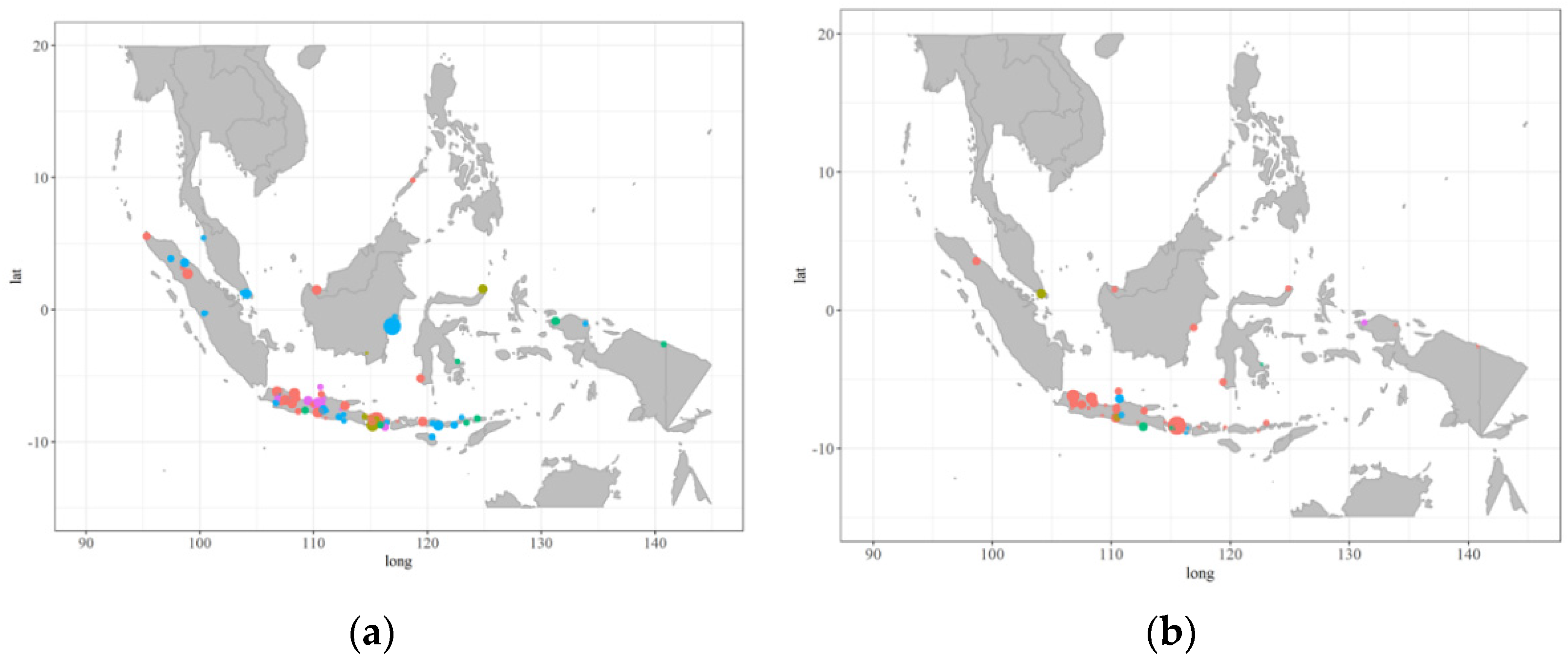


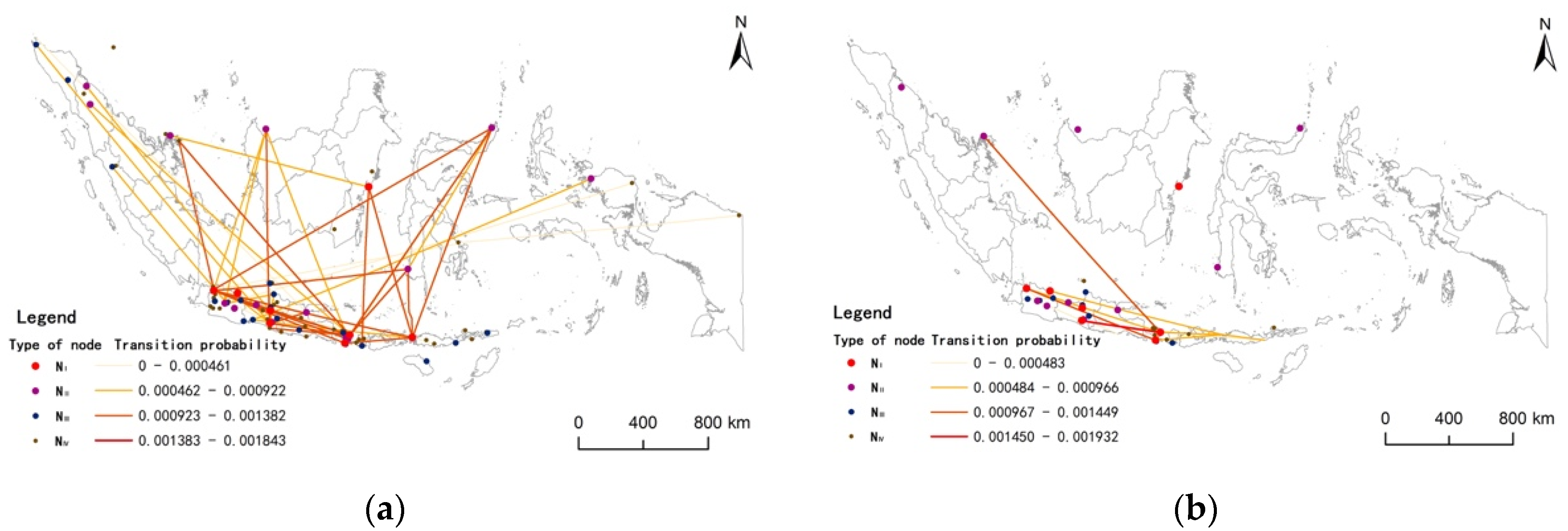


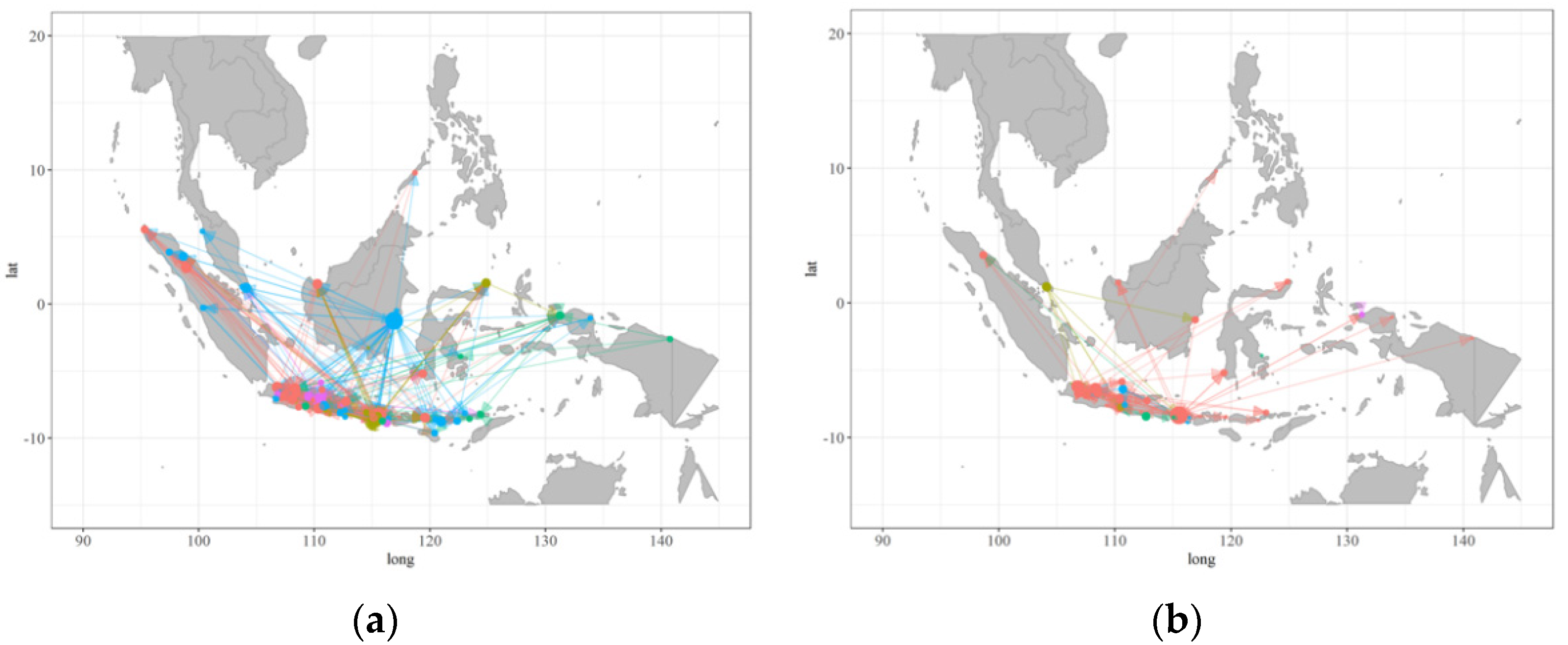


| Number of Nodes | Type and Proportion of Tourism Flow before COVID-19 | Total | |||||||
| 1 | NI | 10.98% | NII | 2.29% | NIII | 3.44% | NIV | 1.39% | 18.1% |
| 2 | NINI | 17.10% | NINII | 5.80% | NINIII | 3.41% | NINIV | 2.20% | |
| NIINII | 2.22% | NIINIII | 1.17% | NIINIV | 1.98% | NIIINIII | 1.22% | ||
| NIIINIV | 1.73% | NIVNIV | 1.49% | 38.32% | |||||
| 3 | NINI | 3.22% | NINII | 3.17% | NINIII | 2.46% | NINIV | 2.24% | |
| NIINII | 2.24% | NIINIII | 1.71% | NIINIV | 1.24% | NIIINIV | 1.73% | ||
| NINIINIII | 1.71% | NINIIINIV | 1.73% | NINIINIV | 0.73% | NIINIIINIV | 0.24% | 22.42% | |
| 4 | NINI | 2.98% | NINII | 1.49% | NINIII | 1.46% | NINIV | 1.24% | |
| NIINIII | 0.73% | NINIINIII | 1.22% | NINIINIV | 1.22% | NIINIIINIV | 0.73% | 11.07% | |
| 5 | NINII | 2.24% | NIINIII | 1.24% | NINIINIII | 1.22% | NINIIINIV | 1.73% | |
| NINIINIIINIV | 0.79% | 7.22% | |||||||
| Number of Nodes | Type and Proportion of Tourism Flow during COVID-19 | ||||||||
| 1 | NI | 38.84% | NII | 20.13% | NIII | 11.38% | NIV | 3.06% | 73.41% |
| 2 | NINI | 2.91% | NINII | 2.34% | NINIII | 2.25% | NINIV | 1.38% | |
| NIINIII | 1.28% | NIINIV | 0.78% | NIIINIV | 0.44% | NIVNIV | 0.34% | 11.72% | |
| 3 | NINII | 1.98% | NINIII | 1.48% | NINIV | 1.03% | NIINIII | 0.78% | |
| NIIINIV | 0.78% | 6.05% | |||||||
| 4 | NINI | 1.74% | NINII | 0.78% | NINIII | 0.78% | NIINII | 0.56% | |
| NINIINIII | 1.13% | 4.99% | |||||||
| 5 | NINIII | 0.24% | NINIIINIV | 0.24% | 0.48% | ||||
Publisher’s Note: MDPI stays neutral with regard to jurisdictional claims in published maps and institutional affiliations. |
© 2022 by the authors. Licensee MDPI, Basel, Switzerland. This article is an open access article distributed under the terms and conditions of the Creative Commons Attribution (CC BY) license (https://creativecommons.org/licenses/by/4.0/).
Share and Cite
Wang, X.; Tang, L.; Chen, W.; Zhang, J. Impact and Recovery of Coastal Tourism Amid COVID-19: Tourism Flow Networks in Indonesia. Sustainability 2022, 14, 13480. https://doi.org/10.3390/su142013480
Wang X, Tang L, Chen W, Zhang J. Impact and Recovery of Coastal Tourism Amid COVID-19: Tourism Flow Networks in Indonesia. Sustainability. 2022; 14(20):13480. https://doi.org/10.3390/su142013480
Chicago/Turabian StyleWang, Xingshan, Lu Tang, Wei Chen, and Jianxin Zhang. 2022. "Impact and Recovery of Coastal Tourism Amid COVID-19: Tourism Flow Networks in Indonesia" Sustainability 14, no. 20: 13480. https://doi.org/10.3390/su142013480
APA StyleWang, X., Tang, L., Chen, W., & Zhang, J. (2022). Impact and Recovery of Coastal Tourism Amid COVID-19: Tourism Flow Networks in Indonesia. Sustainability, 14(20), 13480. https://doi.org/10.3390/su142013480







